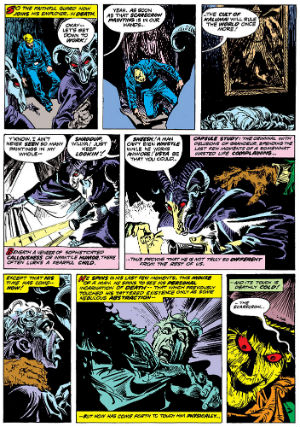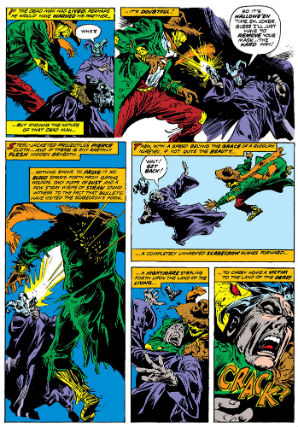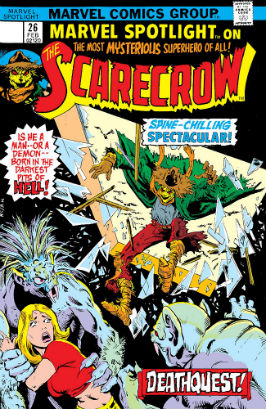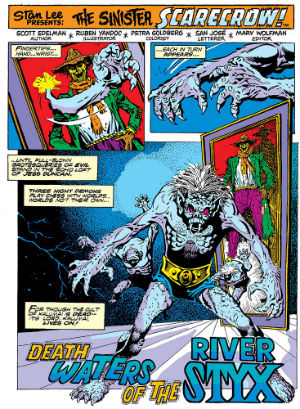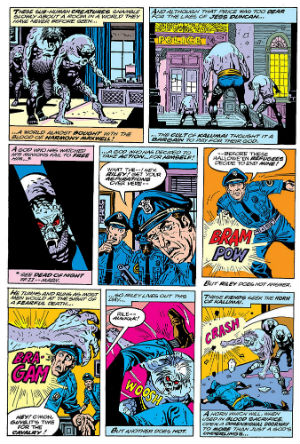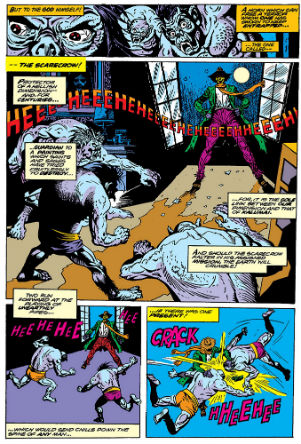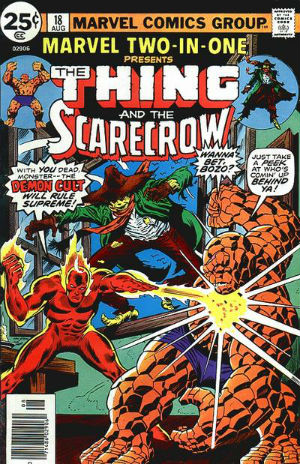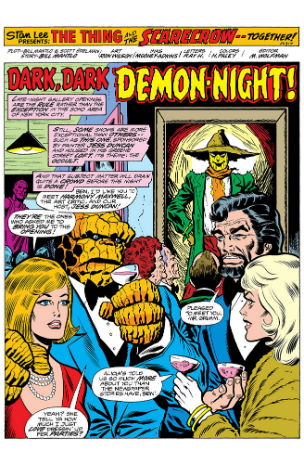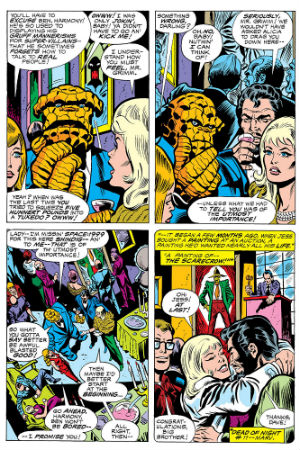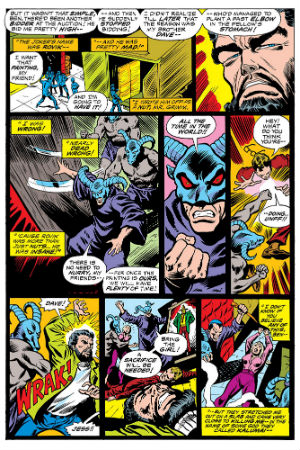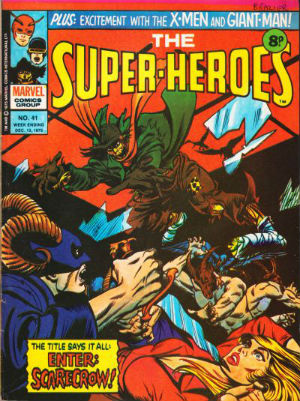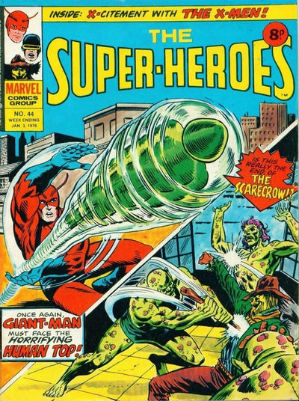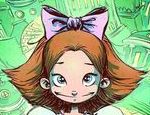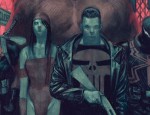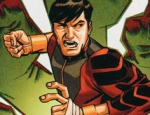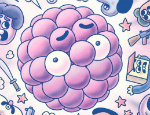Retroflect has a long history at Broken Frontier, having been both a series of blogs and an ongoing column here in the past. Today we return to this irregular feature for looking at pre-millennium comics, from celebrated classics to obscure and largely forgotten titles. Our Halloween subject this time is Marvel’s second (and by far the most intriguing version) of the Scarecrow who debuted as part of their 1970s horror boom. Beware, spoilers will follow…
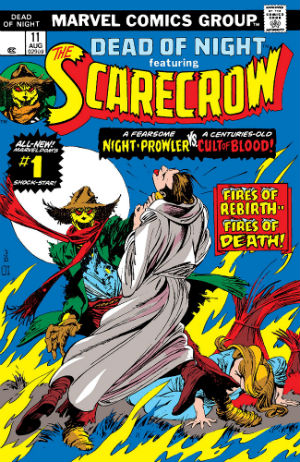 Through the early to mid-1970s Marvel’s horror boom had spawned such long-running series as Tomb of Dracula, Man-Thing and Werewolf By Night, alongside a number of shorter-lived but fondly remembered ones like The Frankenstein Monster, Son of Satan, Tales of the Zombie and the Living Mummy in Supernatural Thrillers. Complementing these with a foot in both the supernatural line and the super-hero world were Morbius the Living Vampire in Adventure into Fear, Man-Wolf in Creatures on the Loose and, of course, Ghost Rider. It was a top time to be a Marvel fear-fan!
Through the early to mid-1970s Marvel’s horror boom had spawned such long-running series as Tomb of Dracula, Man-Thing and Werewolf By Night, alongside a number of shorter-lived but fondly remembered ones like The Frankenstein Monster, Son of Satan, Tales of the Zombie and the Living Mummy in Supernatural Thrillers. Complementing these with a foot in both the supernatural line and the super-hero world were Morbius the Living Vampire in Adventure into Fear, Man-Wolf in Creatures on the Loose and, of course, Ghost Rider. It was a top time to be a Marvel fear-fan!
But amongst all those continuing series were the more short-lived features. Those with just a handful of appearances. Gabriel the Devil Hunter in Haunt of Horror, Satana the Devil’s daughter in Vampire Tales and Brother Voodoo in Strange Tales. Many of these characters would have their spotlight appearances in the anthology magazines of the era or in those monthly titles with a rotating line-up of stars. Undoubtedly the most visually dynamic of them was the Scarecrow (not to be confused with the earlier super-villain of the same name) who made his first appearance in the final issue of Dead of Night #11 (August 1975), as the first original material in what had, up to that point, been one of a number of generic mystery titles reprinting 1950s horror stories.
As much an integral part of the stories as its odd protagonist were the “supporting cast” of brothers Jess and Dave Duncan (an artist and a journalist respectively), and art critic Harmony Maxwell, the latter of whom was Jess’s object of affection. Central to this first story in Dead of Night (set rather topically at Halloween) is the mysterious painting of the Scarecrow around which his three ’70s appearances will largely revolve. A long desired piece for Jess Duncan, his acquisition of it at an auction is much resented by sinister fellow bidder Gregor Rovik, secretly the leader of the malevolent Cult of Kalumai who will plague the cast in this and the subsequent sequel issues.
The painting will be used as a dual story springboard. The Scarecrow’s image stands within its frame as a guardian, as the painting is also a portal to the realm of the demon Kalumai. It acts as both the Scarecrow’s “home” and his responsibility, as he seeks to prevent his nemesis Kalumai from using it to enter the mortal plane. As a mystical artefact of some import, then, it’s a much desired object for the cult in their mission to release their nefarious master. In that initial tale, brought to the eeriest life by the detailed gothic art of Rico Rival and the atmospheric colouring of Glynis Wein, the cult seek to sacrifice Harmony in order to bring Kalumai back to the mortal plane, and are quite brutally dispatched by the Scarecrow for their pains.
What makes the Scarecrow such an intriguingly different character in this story is that he says nothing throughout, apart from ripping loose with that unnerving, cackling laugh. While this relative silence was hardly unique to the character – both the Man-Thing and the Zombie in the horror line of the era were similarly mute – the Scarecrow has far more agency and motivation that those two characters. It gives him an enigmatic allure that will be sadly missing in his post-Seventies appearances that seem to largely miss what gave him his draw in the first place.
In a text page in that first Dead of Night issue, writer Scott Edelman detailed the rather convoluted history of the character before he came to print. Initial concepts were vastly different and included the Scarecrow as a sci-fi escapee from the Microverse of Fantastic Four, an emotion-repressing super-hero, a slain pulp era hero returned to life, and a messenger of god balancing the cosmic scales. No less complicated was the search for a home for the series with the Monsters Unleashed magazine anthology being one mooted possibility. Eventually he found his place in Dead of Night, but if that was meant to be his permanent fixture it was sadly not to be. His debut issue was also Dead of Night‘s finale as it was cancelled with #11.
It would be some months before the Scarecrow would return in the pages of try-out book Marvel Spotlight #26 (February 1976), itself already an established venue for some of the darker corners of the Marvel Universe having hosted Werewolf By Night, Ghost Rider and Son of Satan before they span out into their own books. The Cult of Kalumai are once again intent on freeing Kalumai, with the action this time largely taking place at a press event in an aquarium housing a giant monstrous fish from the depths of the oceans; an occasion which Jess, Dave and Harmony have all attended thanks to Dave’s journalistic connections.
The goat-like Kalumai plays a far more prominent role in this story, albeit trapped in his own dimension, and while the contrived setting exists solely to provide some set pieces with cultists and monstrous aquatic beasts, that can be forgiven as it allows artist Ruben Yandoc to go to town with some gloriously over-the-top visual set pieces. Again the macabre colouring, this time by Petra Goldberg increases the tension, while San Jose’s often melodramatic lettering adds to the grim pantomime of the piece.
At this point it is clear that Edelman is implying that Dave Duncan is somehow connected to the Scarecrow and, indeed, may even be his conduit to the earthly world. Again, the Scarecrow is presented as an unknowable force of super nature; the ultimate “other”, violent and merciless in his uncompromising mission to guard the planet from Kalumai’s intrusion. A year after his first appearance the Scarecrow makes his final appearance of the ’70s in the pages of Marvel Two-in-One #18 (August 1976), the Thing team-up title that would have a history of tying up the dangling plot threads of cancelled comics/features like Skull the Slayer, the Golem and Modred the Mystic.
Edelman co-plots with scripter Bill Mantlo and provides a more natural hook for the meeting of the characters than most team-up tales manage by bringing the Thing’s sculptor girlfriend Alicia Masters into art critic Harmony Maxwell’s world. Ron Wilson’s art veers more towards the super-hero realm which is perhaps fitting in this first foray into the wider Marvel Universe, and one final attempt by Kalumai to escape his confines. This time the Thing and the Scarecrow battle his possessed minions at a gallery exhibition where the Scarecrow’s painting is once more on show. At the end of this adventure the painting is seemingly destroyed, trapping Kalumai and finally ending his threat. But with the painting gone so too is the Scarecrow and the tale ends on a cliffhanger. Was the now missing Dave Duncan a vessel for the Scarecrow all along? And what is his final fate? It’s a plot thread that remains unresolved 40-plus years later.
As an interesting sidenote the Scarecrow stories would be reprinted in Marvel UK’s The Super-Heroes weekly in the 1970s. Scarecrow completists should take note that alongside some new cover appearances by Keith Pollard there were also new splash pages for these stories, necessitated by the British reprints serialising each US story in parts. By the time the Scarecrow returned many years later in Doctor Strange, Sorcerer Supreme, culminating in a cover-led appearance in #38 (February 1992) and finally tying up the Kalumai plot at least, he really bore only a physical resemblance to the character he had once been.
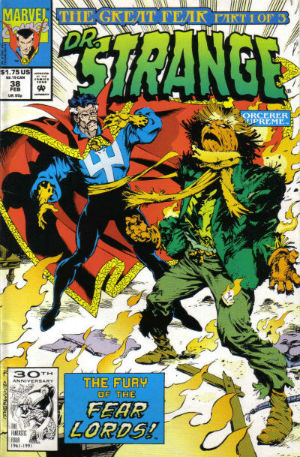 Now he was a member of a group of supernatural creatures known as the Fear Lords and, in what still feels like a rare misstep from that great champion of comic continuity Roy Thomas, he returned as the head of a horror TV studio. No longer an unknowable silent anti-hero, he conversed with other characters and was renamed The Straw Man, presumably to avoid confusion with the original villainous Scarecrow who was enjoying a minor renaissance at the time as a Ghost Rider bad guy. The (dark) magic was well and truly gone and everything that had made the character such a unique presence in the Marvel Universe had been stripped away.
Now he was a member of a group of supernatural creatures known as the Fear Lords and, in what still feels like a rare misstep from that great champion of comic continuity Roy Thomas, he returned as the head of a horror TV studio. No longer an unknowable silent anti-hero, he conversed with other characters and was renamed The Straw Man, presumably to avoid confusion with the original villainous Scarecrow who was enjoying a minor renaissance at the time as a Ghost Rider bad guy. The (dark) magic was well and truly gone and everything that had made the character such a unique presence in the Marvel Universe had been stripped away.
In more recent years the Scarecrow also made a number of post-millenial appearances in Journey Into Mystery as Kieron Gillen gave him a prominent supporting role but his heyday will always be those three scattered 1970s issues and the promise they held. Perhaps one day we will finally find out what happened to poor Dave Duncan, trapped forever in the deepest depths of comics limbo. And yet perhaps it’s also fitting that his fate remains forever up in the air. It’s an apt finale to a series that was always about the enigma and the mystery, and where the answers were always just tantalisingly out of reach…
The three 1970s Scarecrow stories have been reprinted in a number of places over the years including Essential Marvel Horror, the Legion of Monsters hardcover and, most recently, Marvel Horror Omnibus. They are also available on ComiXology.





